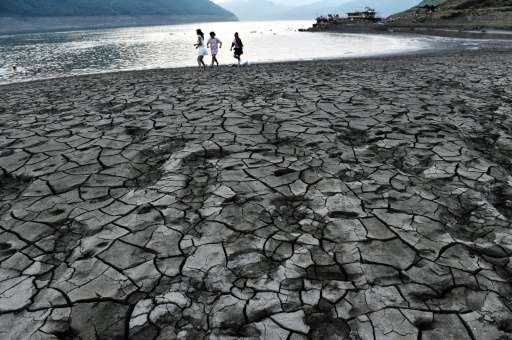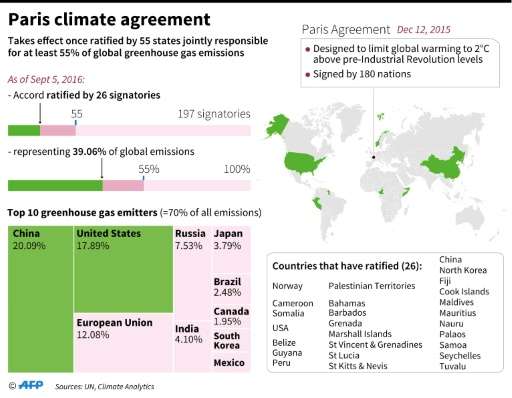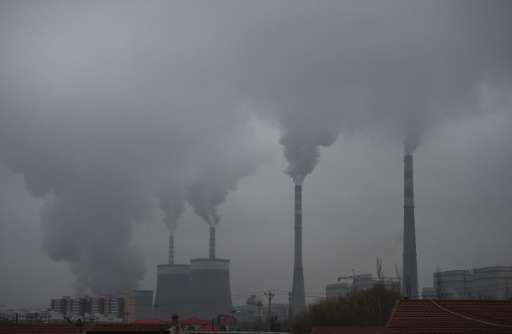Experts see few paths to planet-saving climate goal

The global target to prevent climate catastrophe, crafted at a landmark summit last year in Paris, will be very difficult if not impossible to hit, said some of the world's top scientists meeting this week in Oxford.
The first-ever climate pact to enjoin all nations vows to cap global warming at "well below" two degrees Celsius (3.6 degrees Fahrenheit) compared to pre-Industrial Revolution levels—and under 1.5 C (2.7 F) if possible.
"Currently we only have a few scenarios that get us there, and they are outliers," said Valerie Masson-Delmotte, a climate scientist at Institut Pierre Simon Laplace in Paris, said of the more ambitious goal.
All but a few of the hundreds of complex computer models plotting the rapid reduction of greenhouse gases that drive climate change, in other words, zoom right past it.
"The 1.5 C target took the scientific community by surprise," said Jim Hall, director of the Environmental Change Institute at Oxford, which is hosting the three-day conference ending Thursday.
The question stretches back to the chaotic Copenhagen climate summit in 2009, which nearly derailed more than a decade of UN talks, set the threshold for dangerous global warming at 2 C.
A huge body of scientific literature has accumulated around that benchmark, feeding into periodic reports by the UN's Intergovernmental Panel on Climate Change (IPCC).
But a recent crescendo of devastating impacts—heat waves, deadly flooding, storm surges fuelled by rising seas—pushed world leaders to inscribe even more demanding temperature targets in the Paris pact, inked by 195 nations in December.
The effort was led by small island nations, some of which are likely to disappear under the waves within decades.
Major emerging economies, notably India, went along despite fears that the new threshold would be a brake on economic development.

A political victory
On current trajectories, the world is set to warm at least 3 C (5.4 F) by century's end, a recipe for human misery and species extinction on a global scale, scientists say.
The inclusion of 1.5 C—even as an aspirational goal—was hailed as a political victory, especially by poor, climate-vulnerable nations.
But it caught the scientific community tasked with informing policy makers off-guard.
Top climate scientists gathered in Oxford to help fill this knowledge gap, and to funnel raw material for a major review—mandated by the Paris Agreement—to be delivered in mid-2018.
"The findings from our conference are going to lead directly into the evidence base for the IPCC special report on 1.5 C," Hall said.
"The bad news is that we are already two-thirds of the way there," he added, noting that average global temperatures in 2015—the hottest year on record—were a full degree higher than 150 years ago.
Indeed, the 2018 report is likely to make for grim reading.
A 2 C cap on warming was already seen as hugely ambitious, both technically and politically.
For many scientists, 1.5 C seems virtually impossible—at least not without "over-shooting" the target.
"We may see the first year of 1.5 C above pre-industrial levels within a decade," cautioned Richard Betts, head of climate impacts research at the Met Office Hadley Centre in England.

A 'quick fix'
For some scientists, even setting the target is a bad idea.
"There is a risk that the 1.5 C temperature threshold is a distraction," said Kevin Anderson, Deputy Director of the Tyndall Centre for Climate Research in England.
"The danger is that it will push us to look at geo-engineering solutions rather than how to achieve deep decarbonisation."
Slashing the output of greenhouse gases that heat the atmosphere and oceans—decarbonisation, in other words—has long been the preferred solution to global warming.
But despite a boom in renewables, emissions have continued to grow, putting even a 2 C target out of reach unless engineers find ways to suck CO2 out of the air and store it underground—so-called "negative emissions."
The 1.5 C goal depends on these geo-engineering schemes even more, and could tempt policy makers to opt for "quick fix" solutions rather than a wholesale transformation of national economies, Anderson said.
The problem, scientists agree, is that few of these technologies have moved beyond the experimental stage, and those that have may pose new quandaries.
Schemes that depend on biofuels, for example, would—if scaled up sufficiently to make a real dent in CO2 levels—compete with food crops that scientists say must double in the next 30 years to keep up with an expanding world population.
"Radical changes will be required," said Nebojsa Nakicenovic, deputy director of the International Institute for Applied Systems Analysis, a major centre for climate modelling.
"And not just technically—to be successful, we need new values and norms," he told the conference.
© 2016 AFP



















